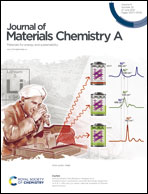Fe–N4 and Co–N4 dual sites for boosting oxygen electroreduction in Zn–air batteries†
Abstract
Compared to individual metal sites, e.g. Fe–N4 sites, the synergistic effect of dual-metal sites can further adjust the interaction of reactants or intermediates with active sites, which is beneficial for boosting the oxygen reduction reaction (ORR) in Zn–air batteries. However, developing a simple and direct method instead of complicated procedures and post-treatment to realize well-defined dual-metal sites is still a grand challenge. Herein, a facile one-step impregnation-pyrolysis route without any post-treatment is developed to controllably synthesize Fe and Co dual-metal sites embedded in hierarchical N-doped carbon from metal–organic frameworks. X-ray absorption spectra coupled with density functional theory calculations demonstrate that the Fe–N4 and Co–N4 dual sites can synergistically enhance the ORR activity. Impressively, the well-controlled FeCo–N–C catalyst exhibits excellent ORR performance, with half-wave potentials (E1/2) of 0.807 and 0.904 V in 0.1 M HClO4 and 0.1 M KOH, respectively. Benefiting from the highly active dual-metal sites and desired porous structure, FeCo–N–C serving as a cathode catalyst achieves an uplifting peak power density of 196.3 mW cm−2 and a remarkable specific capacity of 728.6 mA h gZn−1 at a discharge current density of 20 mA cm−2 in a practical liquid Zn–air battery. Besides this, such superb battery performance is demonstrated in an all-solid-state Zn–air battery.



 Please wait while we load your content...
Please wait while we load your content...